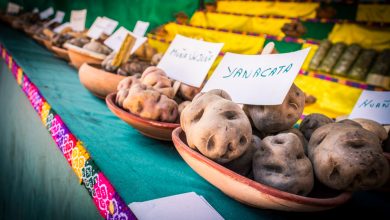Peruvian Cuisine

From cuy to ceviche, Peruvian food embraces a world of diversity. Its roots lie in the indigenous domestication of plants and animals in the Andes, as well as in importations from Africa, China and Europe. Its richness and complexity make it one of the great world cuisines, akin to that of China and France in subtlety and variety, at least if Raymond Sokolow is to be believed.
Like those, it is spreading around the world. In city after city, Peruvian restaurants are appearing and Peruvian cooking is obtaining notice.
Not only is it a food honed in centuries of tradition, it is constantly updating itself.
Contemporary chefs have modernized its traditions, creating Novo Andean cuisine. With the development of culinary schools as well as celebrity chefs, Peruvian restauranteurs have sought to develop their heritage in tune with the finest of the world’s contemporary cooking.
To enter a Peruvian market, either in a building or on the street, is to appreciate the enormous variety of raw ingredients, many of them unknown to outsiders.

Not only have the Peruvians developed perhaps thousands of varieties of potatoes, including ones whose flavor will make you never want to eat a standard russet potato again, they have other indigenous tubers such as the oca. A member of the oxalis family, the oca looks somewhat like a small, thick carrot. But, once harvested and set out to cure in the sun, they develop a sweetness that concentrates when the tubers are roasted to provide a unique taste experience.
The Andeans also have their own grains and seeds. Many unusual varieties of corn await on street corners or in restaurants. These include the big kerneled corn from the Sacred Valley near Cusco. While not as sweet as north American sweet corn, eaten fresh, one kernel at a time, along with salty, white local cheese, this Peruvian gift of the sun will make you wish to find some at home, though in all likelihood it can only be appreciated in Peru.
In contrast, the Peruvian indigenous quinoa, a chenopodium seed related to the common goosefoot, has migrated from Peru to supermarkets and fine restaurants in Europe and the United States. It is unusually high in protein and makes a fine food, especially when ground into a rich gruel and served for breakfast with whole milk and sprinkles of grated cheese.
Peru may well be the origin place for all the world’s chilies. Though that word is from Nahuatl, the language of the Aztecs, Peru contains most of the variety of species as well as the wild forms that may have led to their tremendous florescence once they reached Mexico and the Caribbean, long before Columbus.
Nevertheless, Peru has two species, the hairy-stemmed pubescens, commonly called rocoto, which is fiercely hot with a refreshing, tangy taste, and the long-podded baccatum, from which the well known yellow aji comes. This is a key ingredient for many Peruvian sauces because of its rich, nutty flavor, such as the one made from it roasted and ground with peanuts that is served with skewers of beef, the famous anticuchos of Cusco.
This blog and guide shall explore in detail both the variety and the richness of Peruvian cuisine so that when you visit, you can appreciate the depth and history of the food you find offered there. When you see the almost ubiquitous lomo saltado, stir-fried beef loin, on menu after menu, you will know that this is an early fusion. Chinese workers in the nineteenth century quickly joined a beef, tomato and onion stir fry, with the ubiquitous Peruvian potato and served it with chinese rice. It has become a favorite and one of the most representative of Peruvian dishes around the world.
As Peru’s chefs, culinary experts, and ordinary people develop their food more, they still maintain their roots in one of the world’s great centers of domestication and its uniqueness. Peru truly offers a great world cuisine.




